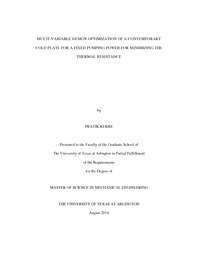
ATTENTION: The works hosted here are being migrated to a new repository that will consolidate resources, improve discoverability, and better show UTA's research impact on the global community. We will update authors as the migration progresses. Please see MavMatrix for more information.
Show simple item record
| dc.contributor.author | Kekre, Pratik | en_US |
| dc.date.accessioned | 2014-07-14T20:21:39Z | |
| dc.date.available | 2014-07-14T20:21:39Z | |
| dc.date.issued | 2014-07-14 | |
| dc.date.submitted | January 2014 | en_US |
| dc.identifier.other | DISS-12734 | en_US |
| dc.identifier.uri | http://hdl.handle.net/10106/24397 | |
| dc.description.abstract | Due to reliability concerns, thermal management of microprocessors has and continues to become a major challenge in electronic packaging. High circuit densities in modern integrated circuit semiconductor devices require the heat generated by their operation be efficiently removed, in order to maintain the temperatures of the device within limits which will consequently follow the design guideline for operating parameters.Air-cooling is still the preferred method of cooling electronic systems and especially in terms of cost. Air cooling, however, is starting to reach its limits for some of the higher end electronic systems and as such there is a need to investigate the application of liquid cooling for cooling high end servers. Also, it has been proved that airflow through circuit boards have inherently low heat transfer coefficients and large pressure drops, and hence requires large heat transfer areas with considerable amount of flow sections. As a result, liquid cooling has grown in prominence as a method for cooling high density interconnect (HDI) devices. Water cooling in particular has multiple advantages over air cooling as it has greater heat carrying capacity. Cold plates enable the use of water with its excellent cooling capability and proven reliability. Previously, optimization work has been done for a classic formed tube cold plate by varying 2 parameters for a fixed pumping power. In this paper we address optimizing the design of a contemporary cold plate for a fixed pumping power by varying multiple design parameters such as the contact width, radius of the curvature, height of the tube. A design of experiment (DOE) on Computational Fluid Dynamics (CFD) is created and deployed such that it maximizes the co-efficient of performance of the cold plate. This would serve as a guideline in the future for design of high performance cold plates that would be employed for thermal management of high power single or multichip modules. | en_US |
| dc.description.sponsorship | Agonafer, Dereje | en_US |
| dc.language.iso | en | en_US |
| dc.publisher | Mechanical Engineering | en_US |
| dc.title | Multi-variable Design Optimization Of A Contemporary Cold Plate For A Fixed Pumping Power For Minimizing The Thermal Resistance | en_US |
| dc.type | M.S. | en_US |
| dc.contributor.committeeChair | Agonafer, Dereje | en_US |
| dc.degree.department | Mechanical Engineering | en_US |
| dc.degree.discipline | Mechanical Engineering | en_US |
| dc.degree.grantor | University of Texas at Arlington | en_US |
| dc.degree.level | masters | en_US |
| dc.degree.name | M.S. | en_US |
Files in this item
- Name:
- Kekre_uta_2502M_12734.pdf
- Size:
- 1.418Mb
- Format:
- PDF
This item appears in the following Collection(s)
Show simple item record


